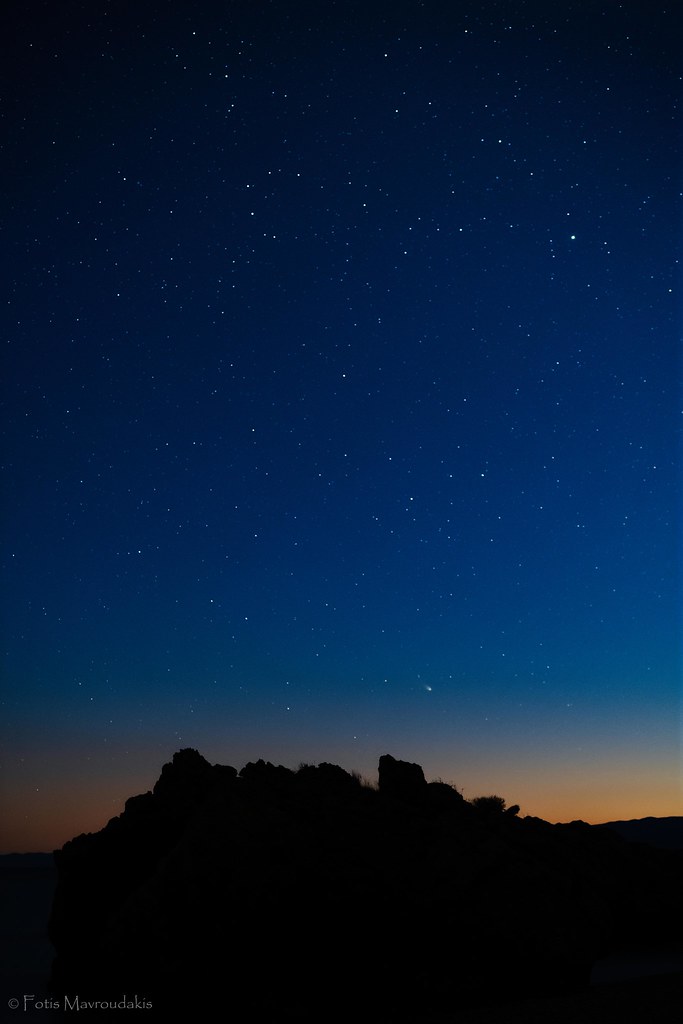Page 4 of 5
Re: Submissions: 2021 December
Posted: Mon Dec 20, 2021 1:40 pm
by mainak
The Spaghetti Nebula (SH2-240)
Simeis 147, also known as the Spaghetti Nebula, or Sharpless 2-240, is a supernova remnant (SNR) in the Milky Way, straddling the border between the constellations Auriga and Taurus. Discovered in 1952 at the Crimean Astrophysical Observatory by Grigory Shajn and his team using a Schmidt camera and a narrowband filter that was close to the Hydrogen Alpha transmission line. It is difficult to observe due to its extremely low brightness.
I captured it in 2 panel mosaic through my GT81 Telescope . It was so faint …so faint..that firstly i was not capable of locating it even, trying it with a manual mount and Redcat 51. So GOTO mount was the only solution .Then I tried the mosaic to capture it. I firstly thought of using Redcat 51 ..but then a planning of mosaic was in my thought and GT 81 came into play. Framing that SNR into the screen was a challange. As far the cloudy nights were in concern, many sessions gone in vain. At last I succeeded to capture it. Actually it was my third attempt to capture that from 2019 and finally after 2 years I was able to get it. The other two were using my ES ED 127 MM APO and REDCAT 51. Learning from the failures before, i was able to image the most difficult target I have ever faced. Also the editing was very very difficult as it was done in different conditions and different day. A memorable experience in my life. I will surely try it again with A Mono Camera , if i buy that in future for more detailing.
Equipments Used :
William Optics GT 81 IV
QHY 294C Pro ( -25 degree Celcius , gain 1610 )
William Optics Uniguide 50 MM Guidescope
ZWO ASI 290 MM Guidecam
Optolong L Enhance Filter
40 Darks 40 Flats for each session
Bortle 4 Zone
Sessions ( 1 to 5 ) :
50 x 240 “ for each session
Integration Time For Each Session : 3 hrs 20 minutes
Total Integration time : 16 hrs 40 minutes
Softwares Used :
Affinity Astrophotography Suite for stacking and editing in each Session
Image Composite Editor and Photoshop for Stitching
Photoshop, Topaz Denoise AI for final editing.

Re: Submissions: 2021 December
Posted: Mon Dec 20, 2021 3:53 pm
by kokehtz
From North America to Crescent Nebula (34 panel mosaic)

full resolution:
https://aipastroimaging.com/wp-content/ ... ic_AIP.jpg
in perspective:
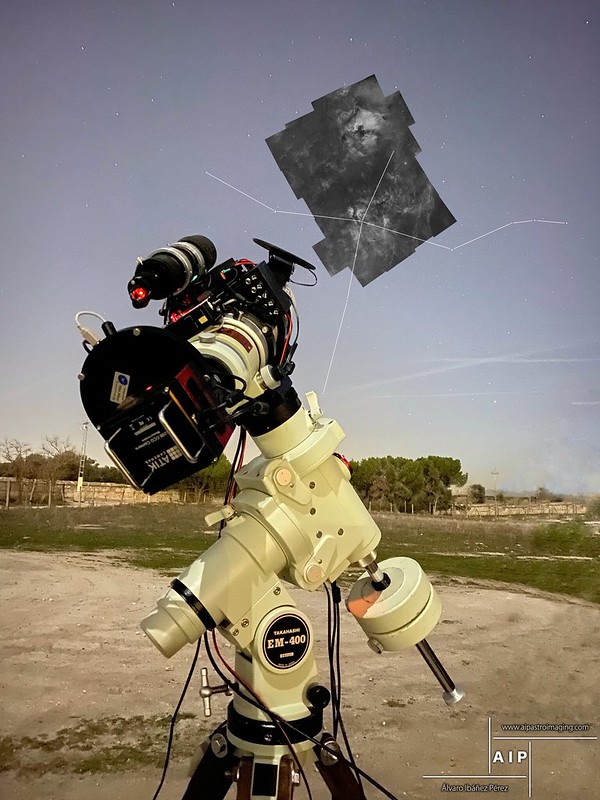
full resolution:
https://live.staticflickr.com/65535/517 ... 332e_o.png
Copyright: Alvaro Ibañez Perez (
www.aipastroimaging.com)
Re: Submissions: 2021 December
Posted: Mon Dec 20, 2021 8:49 pm
by Davor
Real Star!
Each of the following movie stars owes its name (or surname) to real stars, so I decided to represent them using tens of thousands of shots taken of their relative stars.
Using an Askar FMA180 on an Az-GTi, shooting with the QHY163C and the L-Pro filter, from the city of Brescia (Italy), with a Bortle 7 sky, I shot, in their real colors, three very famous stars, Sirio, Betelgeuse and Vega.
Blurring the focus slightly, I captured thousands of frames with SharpCap, saving them directly in TIFF and then converting, cropping and debayerizing them with PIPP, and then feeding them to AndreaMosaic for the final composition.
Each single dot is unique and is not repeated, but above all it shows the original colors of the star, they have not been altered in any way.
Filming (in groups of a few thousand at a time) was all carried out in the night between 19 and 20 December 2021.
Although each portrait is made up of around 10,000 photographs, many more were taken to make sure the dots were all different and to cover most of the dynamic range, shooting with different exposures (for nuances) for a total of 58628 shots and 32 GB of data!
Re: Submissions: 2021 December
Posted: Mon Dec 20, 2021 9:35 pm
by astrohokie
From Wikipedia:
"NGC 281, IC 11 or Sh2-184 is a bright emission nebula and part of an H II region in the northern constellation of Cassiopeia and is part of the Milky Way's Perseus Spiral Arm. This 20×30 arcmin sized nebulosity is also associated with open cluster IC 1590, several Bok globules and the multiple star, B 1. It collectively forms Sh2-184, spanning over a larger area of 40 arcmin. Colloquially, NGC 281 is also known as the Pacman Nebula for its resemblance to the video game character."
Images were calibrated and processed within Pixinsight and combined using a modified SHO palette with Star Xterminantor, noise reduction and curves transformation.
Pacman Nebula (NGC 281)
Celestron EdgeHD 8
Celestron OAG
Celestron Autofocuser
ASI 174MM
ASI 1600MM Pro
ASI 7 position EFW
36 mm Astronomik 6nm Ha, O3, S2 filters
Total Intergration Time = 20 hours
Ha Intergration Time = 76 * 300sec
O3 Intergration Time = 108 * 210sec
S2 Integration Time = 75 * 360sec
Virginia, USA
Bortle 7
NGC 281 Starless
https://telescopius.com/pictures/view/1 ... astrohokie
Copyright: Mark Hoffman
NGC 281 Stars
https://telescopius.com/pictures/view/1 ... astrohokie
Copyright: Mark Hoffman
Re: Submissions: 2021 December
Posted: Tue Dec 21, 2021 2:04 am
by afmolinam
Reaching the Hunter
One of the best known constellations of this time of the year, however when we reach out dark skies and cameras capable of catch the invisible, the true magnitude of the orion constellation is revealed, large nebula complex, abundant deepk sky objects between the known stars, a true place of birth and death of celestian wonders.
https://flic.kr/p/2mRSwyA
https://flic.kr/p/2mRMfWd (annotated version)

Copyright: Andres Molina
Tatacoa Desert, Huila, Colombia
Re: Submissions: 2021 December
Posted: Tue Dec 21, 2021 4:04 am
by Harles99
Comet Lenard C/2021 A1 and the tree line.
Was able to capture a little bit of Comet Leonard as it set tonight. Shot on a Sony FX3 w/ a Rokinon 135mm F2.0 Lens. Stack of three exposures. Shot @ F4.0 , 90" Exposure , ISO 1000 @F4,.0
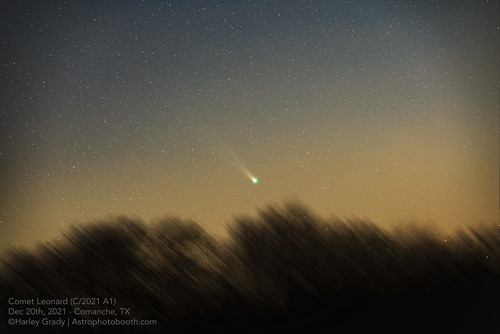 Comet Leonard (C/2021 A1)
Comet Leonard (C/2021 A1) by
Harley Grady, on Flickr
© 2021 Harley Grady | Astrophotobooth
Re: Submissions: 2021 December
Posted: Tue Dec 21, 2021 5:34 pm
by vanamonde81
Solstices
Copyright: György Soponyai
These two photos were taken on the day of Summer Solstice of 2020 and on the day of Winter Solstice of 2021 near Mogyoród, Hungary. Besides demonstrating the celestial path of the Sun, we can recognise the village has been spread out in the past 1.5 years: a forest belt disappeared..
 2020.06.22. + 2021.12.21.
2020.06.22. + 2021.12.21.
Mogyoród, Hungary
Canon EOS 5D Mark II + Samyang EF 24/1.4
Re: Submissions: 2021 December
Posted: Wed Dec 22, 2021 9:54 pm
by barretosmed
GLOBULAR CLUSTER M14 - NGC 6402
Messier 14 (NGC 6402) is a globular cluster of stars located in the constellation Ophiuchus, at a distance of about 30,000 light years from Earth.
BEST DETAILS:
https://www.astrobin.com/full/l289f5/B/
EQUIPMENT:
ZWO ASI 6200MC COLED
Esprit 150mm
CEM60 mount
08/09/2021
Location: Jales - SP - Brazil
Copyright: Fernando Oliveira de Menezes
(Organizing author of the book Astrofotografia Amadora no Brasil
https://clubedeautores.com.br/livro/ast ... -no-brasil
Re: Submissions: 2021 December
Posted: Thu Dec 23, 2021 7:23 am
by Meiying Lee
A Year of Sunrises in Taipei
If you observe the position of the sunrise carefully, you will find that the position of the sunrise moves a lot in a year, more than you think! This is the result of the earth's revolution and the tilt of the earth's rotation axis.
At the bottom of the picture is shortly after the autumnal equinox on October 5, 2012. The sunrise was a little bit south of the east and then continued to the south. At the winter solstice on December 21, the sun will directly hit the Tropic of Capricorn, and the sun will rise in the southernmost position, which is the southernmost position of sunrise during the year. Afterwards, the sunrise position will slowly return to the east. At the spring equinox, the sun will rise from the east. Unfortunately, the spring rains in Taipei are continuous, and the spring equinox sunrise is not recorded. After that, the sun began to move northward. At the summer solstice, the sun will directly hit the Tropic of Cancer. The sun will rise at the most northerly position in the east, which is the most northerly position of the sunrise in the year. The date I recorded is very close to the summer solstice in Jun 18. Afterwards, the sunrise position will slowly return to the east, and on September 24, the autumnal equinox the sun will rise due east, completing the one-year cycle.
These photos were taken from October 5, 2012 to the autumnal equinox of September 24, 2013.
Post-processing Details : Each sunrise photo in the picture is a combination of the sunrise photo of the day and the landscape, and the outline of the hill in the southeast of Taipei is used as a reference for alignment.
Re: Submissions: 2021 December
Posted: Thu Dec 23, 2021 8:04 am
by avilhena
The Three Sisters in Orion
The Three Sisters in Orion, also known as Three Kings or Orion's Belt, is an asterism in Orion's constelation. This constelation is part of humankind for millenia, as it was depicted 30 millenia ago in caves and it is referred in several mythologies.
But while only the stars can be seen at naked eyes, hidden in plain sight lies a nebula field in the same region, featuring the Horsehead and Flame Nebulas, both well known targets for astrophotographers.
Image shot at Santa Susana, Portugal on November 27th and 28th, 2021.
Full resolution:
https://flic.kr/p/2mPyXUP
Copyright: André Vilhena
Technical details:
Telescope: WO RedCat 51 250/f4.9
Mount: SW AZ EQ5-GT
Camera: QHYCCD 268C
Telescope: TSOptics IV/IR Cut Filter
Frames: 268 x 180 s
Re: Submissions: 2021 December
Posted: Thu Dec 23, 2021 2:23 pm
by the_astronomy_enthusiast
 The nebulosity and dust of Auriga
The nebulosity and dust of Auriga by
William Ostling, on Flickr
Full write up here:
https://theastroenthusiast.com/nebulosi ... ga-region/
This image showcases much of the nebulosity in the Auriga region in its natural colors. On the left is the flaming star nebula, an emission-reflection nebulae ionized by the star at its core. The blue parts are reflection, and the red parts are emission. At top center lies the tadpole nebula, a strong emission nebula. On the left are the spider and fly nebulae, two complex regions, of dark nebula, dust, emission nebulae, and reflection nebulae. Below these two nebula is an open star cluster.
Website:
https://theastroenthusiast.com/
Instagram:
https://www.instagram.com/the_astronomy_enthusiast/
Re: Submissions: 2021 December
Posted: Thu Dec 23, 2021 3:51 pm
by atomo
Hello folks here VELA_SNR
Telescope: SharpStar 150 f2,8
Guide Scope:Evoguide
Mount : Skywatcher HEQ5
Imaging camera: ZWO 2600MC
Guiding camera: ZWO 290 MC
Filters: Idas NBZ
Plate solving: SGpro
Imaging software: Sgpro
Guiding software: PHD2
Processing software: Pixinsight
NBZ 210X120s exposure@100Gain
Integration: 7 hrs
copiright@Davide Mancini
Instagram:
https://www.instagram.com/da_ma_astro/
Flickr:
https://www.flickr.com/photos/189096298@N06/
Re: Submissions: 2021 December
Posted: Thu Dec 23, 2021 8:58 pm
by airliner
Re: Submissions: 2021 December
Posted: Fri Dec 24, 2021 8:21 am
by Mathieu80
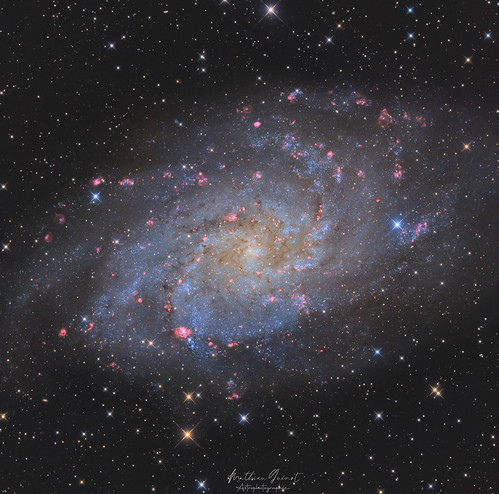 M33
M33 by
Mathieu Guinot, sur Flickr
Hi all,
Here is the famous M33, taken from my backyard (France, Bortle 7) in november and december 2021.
Exposure : 21h30
Newton Lacerta 250mm f/3.8 telescope
IOptron CEM120 mount
ZWO Astronomy Cameras ASI 2600mm
LRGB & Halpha 3.5nm Antlia Astronomy Filter
L: 349x120s (11h38)
RGB: 30x120s (1h) / 44x120s (1h28) / 50x120s (1h40)
Halpha: 68x300s (5h40)
Sampling : 0.8"/pixel
Average FWHM : 2-2.5"
Processing : Pixinsight & Photoshop
Mathieu Guinot
Re: Submissions: 2021 December
Posted: Fri Dec 24, 2021 8:25 am
by Mathieu80
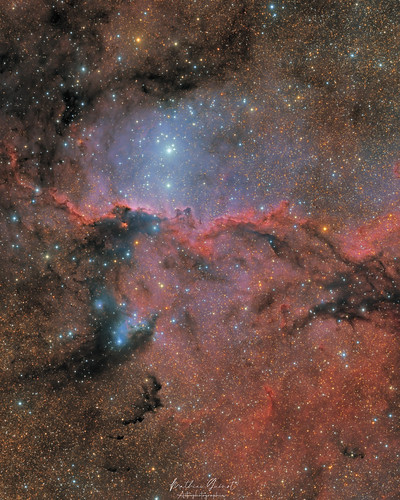 ngc6888_Lrvb
ngc6888_Lrvb by
Mathieu Guinot, sur Flickr
Hi all !
Here is the famous NGC6188 Fighting dragons of Ara.
LRGB processing from a free data set provided by Deep Sky West remote observatory and taken with Takahashi TOA150 and FLI ML16200 camera.
Exposure : 20h15
Best regards,
Mathieu
Re: Submissions: 2021 December
Posted: Fri Dec 24, 2021 8:26 am
by Mathieu80
 LDN 1622 LHaRhaVB
LDN 1622 LHaRhaVB by
Mathieu Guinot, sur Flickr
Hi all !
Here is LDN 1622 dark nebula in Orion. It is known as the Boogie Man Nebula due to both its shape and its dark color.
LRHAGB processing from a free data set provided by Deep Sky West remote observatory and taken with Takahashi FSQ106 and QSI683 camera.
Exposure : 32h30
Best regards,
Mathieu
(Tiny) Partial Solar Eclipse at Sunset - 4th December 2021
Posted: Fri Dec 24, 2021 10:53 am
by philhart
The total solar eclipse in Antarctica at the start of December was just visible as a tiny partial solar eclipse at sunset, along the southern coast of Victoria (Australia). I observed and photographed it from Wilsons Promontory National Park, affected by some high cloud on the horizon 200km away.
First image below is through solar filter. Second image is unfiltered with sun heavily extinguished close to the horizon and through cloud.
Blog post with the full story:
http://philhart.com/partial-eclipse-at- ... ember-2021
Phil
Skywatcher EvoStar 150 with 1.5x extender @1800mm (with solar filter) - Sony A7 III (video frame)
Skywatcher EvoStar 150 with 1.5x extender @1800mm (unfiltered, except by cloud) - Sony A7 III (video frame, 1/4000 sec ISO100)
Oh Christmas Tree
Posted: Sat Dec 25, 2021 1:58 am
by MrRat
Cone Nebula atop the Christmas Tree Cluster
Taken December 24th, 2021 from my backyard.
66 shots at 300 seconds each for a total of 5 hours of exposure.
Shot with a ZWO ASI2600MC camera, William Optics GT81 telescope, and Losmandy GM811G equatorial mount.
James Webb Telescope on tour..
Posted: Sun Dec 26, 2021 11:57 am
by astrohardy
Hello,
Last night I could record the James Webb Telescope using the JPL Horizon ephemeris . A, galaxy, an unidentified satellite and the Ariane-5 terminal rocket stage were also recorded:

Link to my Flickr page providing full size:
https://www.flickr.com/photos/astrohard ... ed-public/
Location: Schmalenbeck, Germany
Time: 2021-12-25 Pentax 75 SDHF + Reducer, effective fl=365mm, Camera ZWO ASI1600MM, 21:51-22:30UT. 20s subs, L filter
I stacked the images using DSS using the maximum pixel value in order to bring up the trails. The James Webb telescope was about 11mag. It appeared on the 20s subs as a slightly elongated "star" that shifted its position from image to image.
For comparison a plot of the Horizon ephemeris on the Guide 9.1 starmap showing the good agreement with my picture.
https://www.flickr.com/photos/astrohard ... ed-public/
Thanks for the consideration
Hartwig Lüthen
hartwig.luethen@uni-hamburg.de
Re: Submissions: 2021 December
Posted: Sun Dec 26, 2021 4:58 pm
by mi7sen
Target : Sun - Our star
Location:
Kuwait - Kuwait City
Description:
are we really that small! I tried to scale earth as close as possible compared to the sun and I may be a little off as we are tiny in comparison but wow! provided is a single panel of the mosaic and a mosaic of the full disk.
where to start! wow. this has been a goal of mine for a long time, to image our sun up close and personal. the sheer difference of technique and time and effort required to image the sun is outstanding. also the fact that our sun is ever changing means everytime you image there is a slight difference. while I had some technical and mechanical issues I was thankfully able to work around them and I present to you my results. hopefully in a few days I will be receiving a new dedicated camera which I plan to use to image the sun to pull more details out. stay tuned!
Equipment:
° Mount: Rainbow Rst-135
° Main Imaging: ZWO 462mc
° OTA: Lunt LS100MT modular day and night telescope
° Aquisition Device: Lenovo Yoga slim 7 laptop with Sharpcap
° Filter: Lunt B1800 blocking filter and H-alpha pressure tuned filter system
Re: Submissions: 2021 December
Posted: Sun Dec 26, 2021 5:00 pm
by mi7sen
My apologies forgot to add my name is Abdulmohsen Alreesh and you can find more of my work on Instagram under the account @mi7sen89 or on astrobin under the name Abdulmohsen Alreesh
mi7sen wrote: ↑Sun Dec 26, 2021 4:58 pm
Target : Sun - Our star
Location:
Kuwait - Kuwait City
Description:
are we really that small! I tried to scale earth as close as possible compared to the sun and I may be a little off as we are tiny in comparison but wow! provided is a single panel of the mosaic and a mosaic of the full disk.
where to start! wow. this has been a goal of mine for a long time, to image our sun up close and personal. the sheer difference of technique and time and effort required to image the sun is outstanding. also the fact that our sun is ever changing means everytime you image there is a slight difference. while I had some technical and mechanical issues I was thankfully able to work around them and I present to you my results. hopefully in a few days I will be receiving a new dedicated camera which I plan to use to image the sun to pull more details out. stay tuned!
Equipment:
° Mount: Rainbow Rst-135
° Main Imaging: ZWO 462mc
° OTA: Lunt LS100MT modular day and night telescope
° Aquisition Device: Lenovo Yoga slim 7 laptop with Sharpcap
° Filter: Lunt B1800 blocking filter and H-alpha pressure tuned filter system
Re: Submissions: 2021 December
Posted: Sun Dec 26, 2021 9:33 pm
by stoker

TS APO 76EDPH - ASI 2600MC
14h RGB + 19h HA extract from DUO NB filter
Bortle 4 / SQM 21
Martin Hochbruck - Whitch head 3 DEZ 2021 GAUCIN by
Martin Hochbruck, auf Flickr
Re: Submissions: 2021 December
Posted: Mon Dec 27, 2021 2:38 pm
by the_astronomy_enthusiast
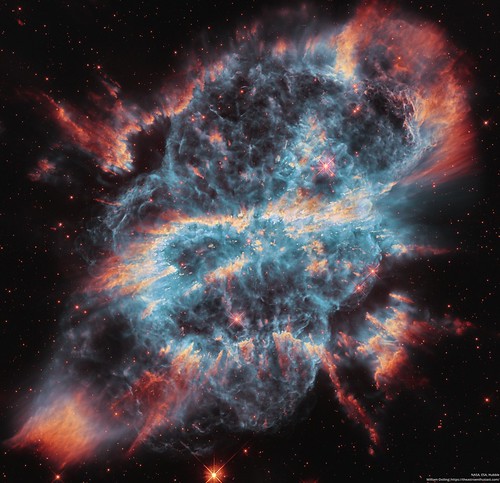 NGC5189
NGC5189 by
William Ostling, on Flickr
Full write up here:
https://theastroenthusiast.com/ngc-5189-from-hubble/
Why is this beautiful nebula so complicated ? When a star is dying, it blast away its outer layers, usually into a simple overall shape. Sometimes this shape is a sphere, sometimes a double lobe, and sometimes a ring or a helix. In this image, however, no such simple structure has emerged. To help find out why, Hubble Space Telescope recently observed NGC 5189 in Hydrogen, Oxygen and Sulfur emission lines. Previous findings indicated the existence of multiple periods of material outflow, including a recent one that created a bright but distorted bar-like feature running horizontally across image center. Results appear consistent with a hypothesis that the dying star is part of a binary star system with a precessing symmetry axis. Given this new data, though, research is sure to continue.
Website:
https://theastroenthusiast.com/
Instagram:
https://www.instagram.com/the_astronomy_enthusiast/
Re: Submissions: 2021 December
Posted: Mon Dec 27, 2021 4:03 pm
by astrohardy
One night after my previous photograph the departing Webb Space Telescope passed directly north of the Horsehead and the Flame nebula, giving perhaps a view more compatible to pretty-picture astrophotography...Accoring to the JPL Horizon ephemeris it was 0.001761aU from me (=263000km). The Webb Telescope was 2 magnitudes fainter than last night and its movement in the sky was much much slower. Telescope: Pentax 75 SDHF with reducer (f=365mm), camera: ZWO ASI 1600MM. Exposure of the subs was 46s, the image shown is an R-RGB. Stacked with Deepsky Stacker, edited with Fitswork, Pixinsight and Photoshop. I did this in Schmalenbeck, Germany (just northeast of the city of Hambuirg). The left trail above the flame nebula is the Webb telescope; the trail in the upper right part is the Ariane-5 booster stage.

Link to the image on flickr
https://www.flickr.com/photos/astrohard ... 3/sizes/c/
There is also an unedited version of the red channel on the same Flickr channel.
Hartwig Lüthen
Re: Submissions: 2021 December
Posted: Mon Dec 27, 2021 5:31 pm
by mi7sen
Solar flare in Kuwait City
imaged this morning I managed to get this stunning solar flare and sun spots from my roof in Kuwait. Imaged using a Lunt LS100MT and asi120mm on a rainbow rst-135 mount.
the surface detail was 1000 frames and the proms were also 1000 frames stacking a total of 5% of each.
Software used
Sharpcap for aquisition
AS! 3 for stacking
Impgg and Astro Surface for details
and Adobe Photoshop for curves, colors and final tweaks.
feel free to see more of my images on Instagram under the handle @mi7sen89
or via astrobin under the name Abdulmohsen Alreesh
Thank you!
Abdulmohsen Alreesh











